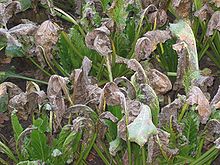| Cercospora beticola | |
|---|---|

| |
| Cercospora beticola on sugarbeets | |
| Scientific classification | |
| Domain: | Eukaryota |
| Kingdom: | Fungi |
| Division: | Ascomycota |
| Class: | Dothideomycetes |
| Order: | Capnodiales |
| Family: | Mycosphaerellaceae |
| Genus: | Cercospora |
| Species: | C. beticola
|
| Binomial name | |
| Cercospora beticola Sacc., (1876)
| |
Cercospora beticola is a fungal plant pathogen which typically infects plants of the genus Beta, within the family of Chenopodiaceae. It is the cause of Cercospora leaf spot disease in sugar beets, spinach and swiss chard. Of these hosts, Cercospora leaf spot is the most economically impactful in sugar beets (Beta vulgaris). Cercospora beticola is a deuteromycete fungus that reproduces using conidia. There is no teleomorph stage. C. beticola is a hemibiotrophic fungus that uses phytotoxins specifically Cercospora beticola toxin (CBT) to kill infected plants. CBT causes the leaf spot symptom and prevents root formation. Yield losses from Cercospora leaf spot are around 20 percent.[1][2][3][4]
- ^ Cite error: The named reference
:0was invoked but never defined (see the help page). - ^ Cite error: The named reference
:1was invoked but never defined (see the help page). - ^ "Sugarbeets". hort.purdue.edu. Retrieved 2016-12-07.
- ^ Schlösser, Eckart (1971-01-01). "The Cercospora beticola toxin". Phytopathologia Mediterranea. 10 (2): 154–158. JSTOR 42684069.